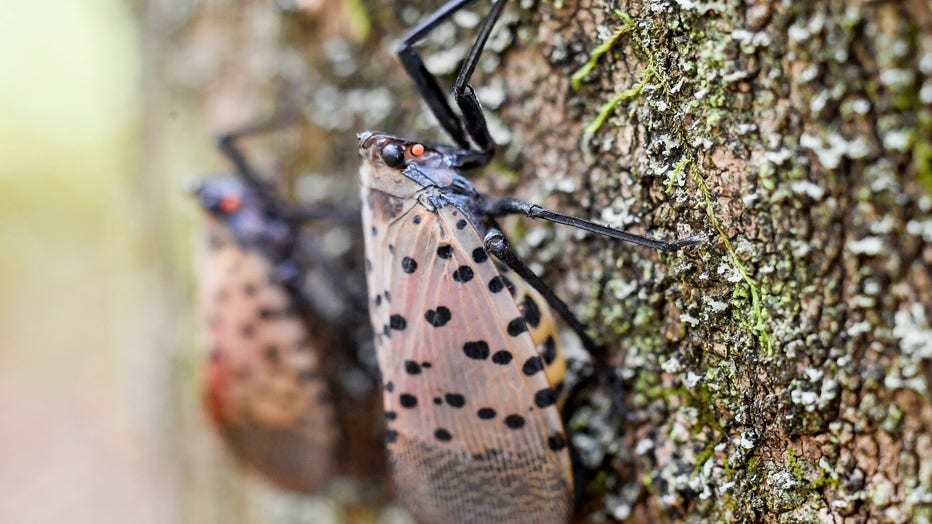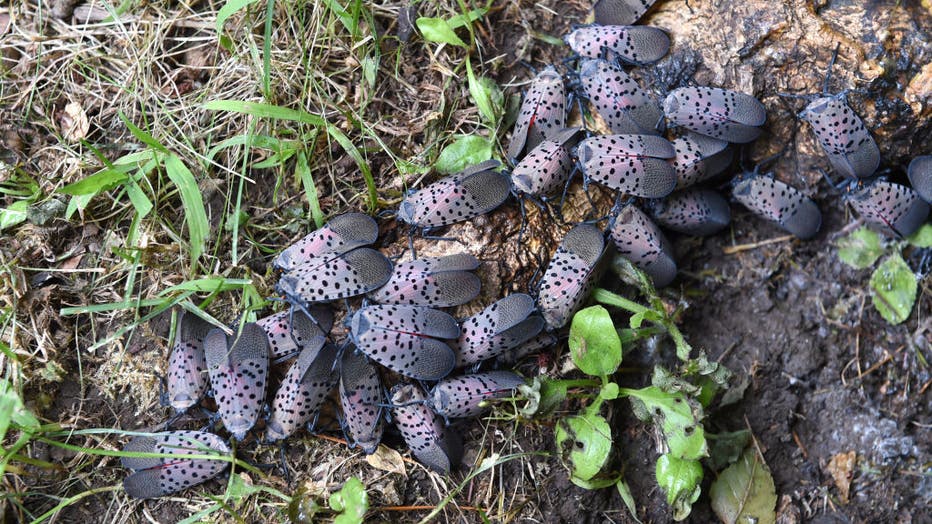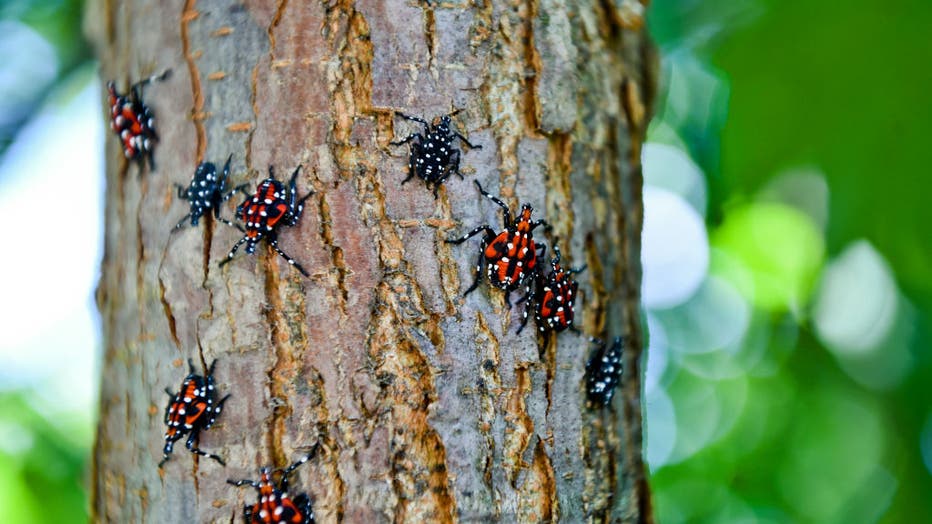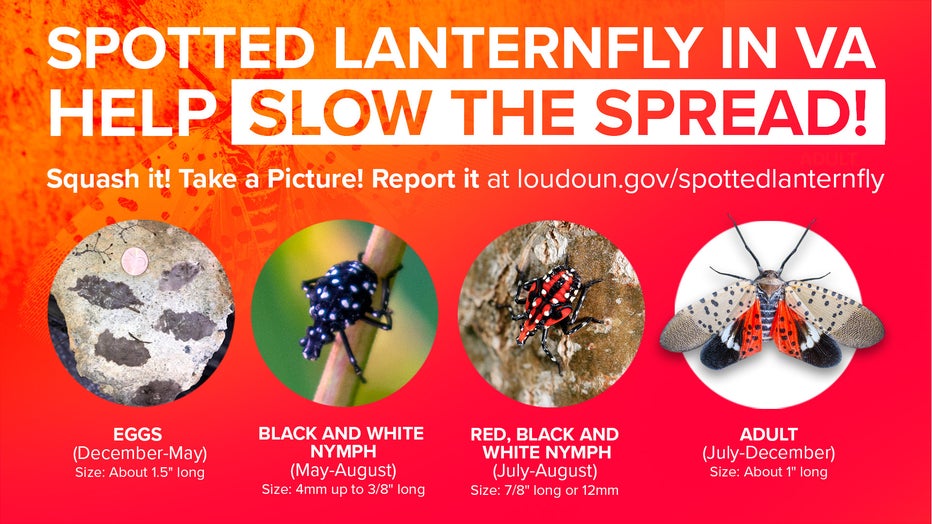Invasive spotted lanternfly found in Loudoun County
LOUDOUN COUNTY, Va. - Officials in Loudoun County, Virginia are reminding residents to be on the lookout for the spotted lanternfly, an invasive species of insect that can wreak havoc on plant life in areas they infest.
Officials announced Wednesday that spotted lanternflies have now been found in Loudoun County, and in response they are providing some tips for how county residents can help limit the spread of the invasive species.
The insects, which are native to Asia, prefer feeding on a plant called Tree of Heaven, but will also feed on more than 100 other plant species, including grapes, peaches, apples and walnuts. The spotted lanternfly is not harmful to humans and pets, but can be a serious nuisance pest to property owners when present in high numbers. As they feed, the insects secrete a substance that can build up under plants and promote growth of black, sooty mold.

Shillington, PA - October 27: Two adult spotted lanternfly on the side of a tree in Shillington Park Wednesday morning October 27, 2021. The spotted lanternfly is an invasive species. (Photo by Ben Hasty/MediaNews Group/Reading Eagle via Getty Images
Over the past few years, the invasive insect has been detected in Pennsylvania and in parts of Virginia, including Winchester, Charlottesville and Prince William County. Virginia officials have been tracking the spotted lanternfly for more than four years.
Officials say the spotted lanternfly can spread to un-infested areas through natural means or through artificial means, such as inadvertently being transported on cars and goods like firewood.
The life cycle of the spotted lanternfly begins in mid-spring when they hatch from egg clusters. The immature spotted lanternflies are active in the spring. They are no more than a quarter inch in length, and they can be either black or red with white spots. Adult spotted lanternflies appear in the summer and fall and are about an inch long.
READ MORE: Off-cycle cicada stragglers start to emerge in parts of DC region
As a result of the insects spreading, several Virginia counties have been placed under a quarantine by the Virginia Department of Agriculture and Consumer Services (VDACS). These counties are Albemarle, Augusta, Carroll, Clarke, Frederick, Page, Prince William, Rockbridge, Rockingham, Shenandoah and Warren.

Spotted Lanternfly feast on a tree root emerging from the ground on the property of Piper Sherburne near Landis Store in District Township. BC Last Look Spotted Lanternfly Photo by Harold Hoch 8/10/16 (Photo By Harold Hoch/MediaNews Group/Reading Eag
Businesses in the quarantined area are required to obtain a permit from VDACS and inspect all regulated articles leaving the quarantined area to ensure that the articles do not contain any life stage of the spotted lanternfly. Items considered to be a risk for the movement of spotted lanternfly to un-infested areas include:
- Live or dead trees; nursery stock; green lumber; firewood; logs; perennial plants; garden plants or produce; stumps; branches; mulch; or composted or un-composted chips, bark, or yard waste;
- Outdoor industrial or construction materials or equipment; concrete barriers or structures; stone, quarry material, ornamental stone, or concrete; or construction, landscaping, or remodeling waste;
- Shipping containers, such as wood crates or boxes;
- Outdoor household articles, including recreational vehicles; lawn tractors or mowers; grills; grill or furniture covers; tarps; mobile homes; tile; stone; deck boards; or
- Any equipment, trucks, or vehicles not stored indoors; any means of conveyance utilized for movement of an article; any vehicle; or any trailer, wagon.

Spotted lanternfly nymphs are pictured near the Pagoda on Monday, July 16, 2018. Photo by Natalie Kolb (Photo By Natalie Kolb/MediaNews Group/Reading Eagle via Getty Images)
To help slow down the spread of the insects, Loudoun County officials say there are four actions residents can take:
- Educate themselves about the spotted lanternfly to be able to recognize the insect throughout its life cycle.
- Inspect your surroundings; look for spotted lanternfly egg masses and insects by checking tree trunks, wheel wells, under and around vehicles, lawn furniture, fences, storage sheds, rocks, metal surfaces (especially if they are rusty) and other smooth surfaces.
- Kill live insects on sight and squash/scrape off their egg masses.
- Take a photo of the bugs and/or egg masses and report the finding here to help track the spread of the invasive insect.
RELATED: Cats classified as 'invasive alien species' by respected scientific institute
Officials also say that property owners can take these actions to prevent the insects from spreading on their properties:
- Removing the Tree of Heaven, which is a favorite host of the insect.
- Keeping trees and shrubs in good health to help them better resist and recover from the impacts of the spotted lanternfly.
- Some commercially available insecticides are effective against the spotted lanternfly. You can learn more about which pesticides to use here.

"Increased public awareness and vigilance is a critical tool in slowing the spread of this damaging insect," said Beth Sastre, a horticulturist with the Virginia Cooperative Extension (VCE Loudoun). "Because the spotted lanternfly’s appearance changes dramatically throughout its life cycle, we encourage residents to take the time to learn how to recognize the different stages and to take steps to remove the insect from their property."
READ MORE: Invasive Joro spider expected to swarm DMV in summer
To further help residents and businesses, VCE Loudoun is offering trainings designed to equip them with important information on controlling spotted lanterfly populations. To request a training session, contact VCE Loudoun by email at loudounMG@vt.edu or by phone at 703-777-0373.

